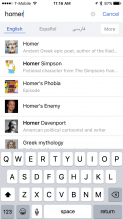As a user I should be able to see search results in different languages side by side.
We are going to show 3 languages by default and a more button which opens the traditional language picker.
The spec for deciding which 3 languages is pending. for now if we can get languages from iOS or keyboard settings that would work.











